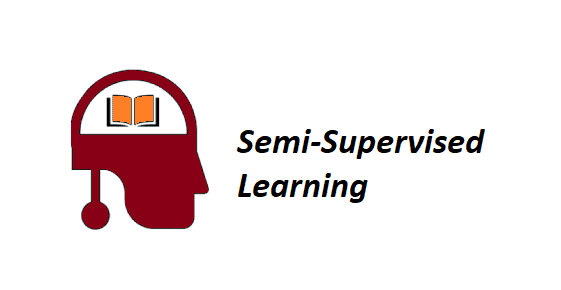Semi-Supervised Learning
In this page we will learn about What is Semi-Supervised Learning?, Assumptions followed by Semi-Supervised Learning, Working of Semi-Supervised Learning, Difference between Semi-supervised and Reinforcement Learning, Real-world applications of Semi-supervised Learning.
What is Semi-Supervised Learning?
Semi-Supervised learning is a type of Machine Learning algorithm that represents the intermediate ground between Supervised and Unsupervised learning algorithms. It uses the combination of labeled and unlabeled datasets during the training period.

You should be familiar with the key categories of Machine Learning algorithms before diving into Semi-Supervised Learning. Supervised Learning, Unsupervised Learning, and Reinforcement Learning are the three main types of machine learning. Furthermore, the primary distinction between supervised and unsupervised learning datasets is that supervised datasets include output label training data for each tuple, but unsupervised datasets do not. Between supervised and unsupervised machine learning, semi-supervised learning is an important category. Although semi-supervised learning acts on data with a few labels and is the middle ground between supervised and unsupervised learning, it largely consists of unlabeled data. Labels are expensive, yet for corporate purposes, a few labels may suffice.
The primary downside of supervised learning is that it necessitates manual labeling by machine learning experts or data scientists, as well as a high processing cost. Furthermore, the range of applications for unsupervised learning is limited. The notion of semi-supervised learning is introduced to solve the shortcomings of supervised and unsupervised learning algorithms. The training data in this algorithm is a mix of labeled and unlabeled data. However, there is a very little amount of labeled data compared to the vast amount of unlabeled data. Similar data is first clustered using an unsupervised learning technique, which then aids in labeling unlabeled data into labeled data. It is for this reason that labeled data is more expensive to acquire than unlabeled data.
With the help of an example, we can visualize these algorithms. At home and in college, supervised learning refers to when a student is under the supervision of an instructor. Unsupervised learning occurs when a learner self-analyzes the same subject without the assistance of the instructor. In semi-supervised learning, the learner must revise after evaluating the same subject with the help of a college instructor.
Assumptions followed by Semi-Supervised Learning
There must be a relationship between the objects in order to work with the unlabeled dataset. Semi-supervised learning is based on one or more of the following assumptions:
- Continuity Assumption: According to the continuity assumption, things that are close together are more likely to belong to the same group or category. This assumption is also utilized in supervised learning, with decision boundaries separating the datasets. The decision boundaries are combined with the smoothness assumption in low-density boundaries in semi-supervised learning.
- Cluster assumptions: Data is separated into discrete clusters in this assumption. Furthermore, the output label is shared by all points in the same cluster.
- Manifold assumptions: This assumption aids in the utilization of distances and densities, and these data are distributed on a manifold with less dimensions than the input space.
- The dimensional data is generated via a process with fewer degrees of freedom, making it difficult to model directly. (If the probability is high, this assumption becomes feasible.)
Working of Semi-Supervised Learning
Semi-supervised learning, unlike supervised learning, uses pseudo labeling to train the model using less labeled training data. Various neural network models and training methods can be combined in this process. The following points will illustrate how semi-supervised learning works:
- To begin with, it trains the model with a less amount of training data than supervised learning models. The model is trained until it produces correct results.
- In the next stage, the algorithms employ the unlabeled dataset with pseudo labels, and the output may no longer be correct.
- The pseudo labels data and the labels from labeled training data are now linked.
- In addition, the input data in labeled and unlabeled training data are linked.
- Finally, like in the previous phase, retrain the model with the new combined input. It will reduce errors and increase the model's accuracy.
Difference between Semi-supervised and Reinforcement Learning
Reinforcement learning differs from semi-supervised learning in that it uses rewards and feedback to motivate students. Reinforcement learning aims to maximize the rewards by their hit and trial actions, whereas in semi-supervised learning, we train the model with a less labeled dataset.
Real-world applications of Semi-supervised Learning
In the industry, semi-supervised learning models are becoming more common. The following are some of the most common applications.
- Speech analysis: It is the most well-known use of semi-supervised learning. Because classifying audio data is the most difficult operation that necessitates a large number of human resources, this problem can be naturally solved by using SSL in a semi-supervised learning model.
- Web content classification: However, labeling each page on the internet is extremely important and impossible because it requires significant human interaction. Even yet, using Semi-Supervised Learning Algorithms, this problem can be mitigated. Furthermore, Google ranks a webpage for a particular query using semi-supervised learning algorithms.
- Protein sequence classification: because DNA strands are longer, significant human intervention is required. In this field, the rise of the semi-supervised model has been close.
- Text document classifier: As we all know, finding a significant amount of labeled text data is nearly impossible, therefore semi-supervised learning is a great way to get around this.